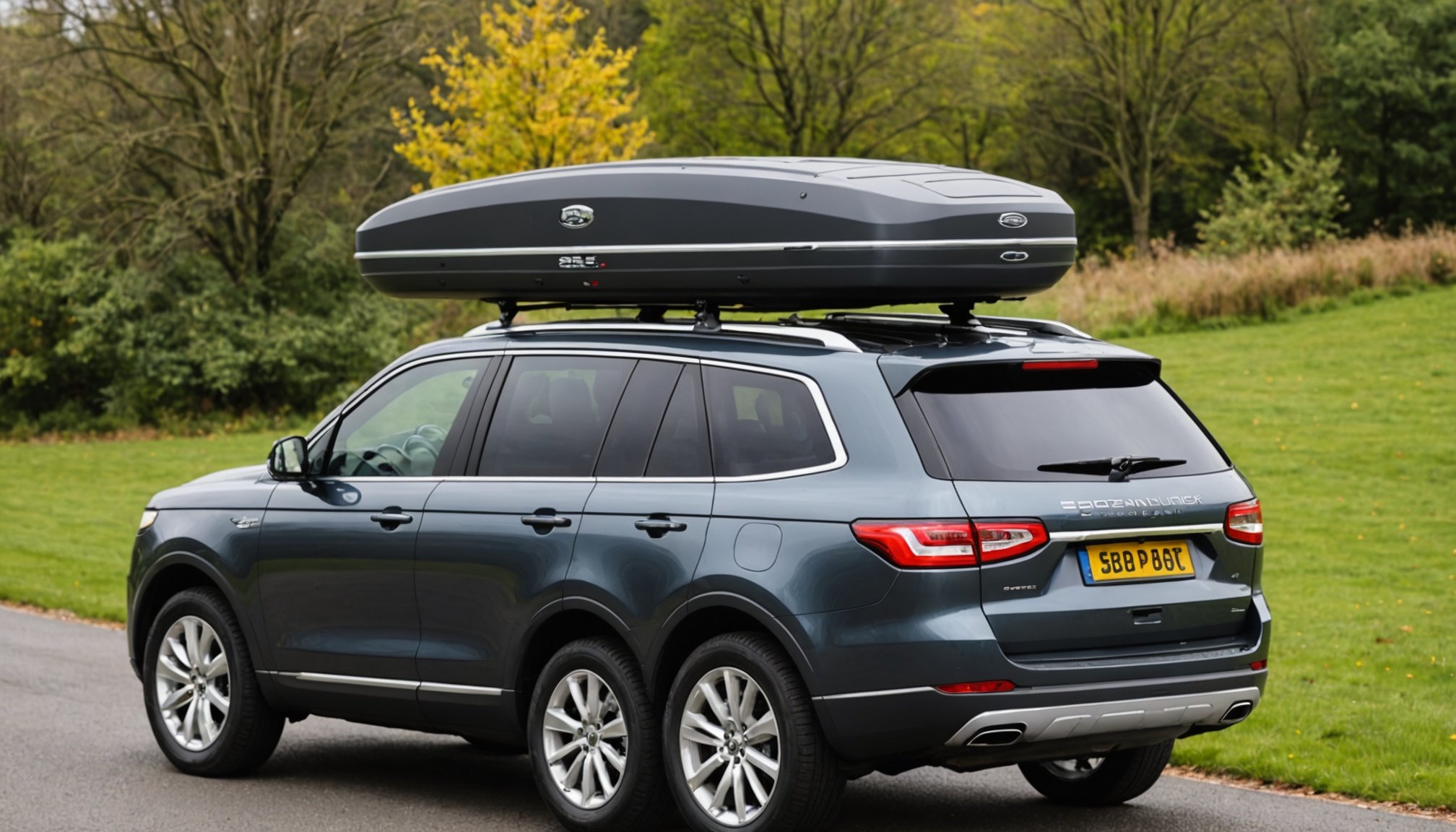Introduction to Roof Cargo Boxes
Roof cargo boxes are popular storage solutions for SUV owners, especially in Britain. They serve as essential accessories that significantly increase a vehicle’s storage capacity, making them ideal for road trips and outdoor adventures. These boxes are designed to fit on the roof, allowing more room inside the SUV for passengers and other essentials. The additional storage space enables adventurers to carry more gear, luggage, or sporting equipment, effectively transforming an SUV into a ready-to-go travel companion.
There are various styles and types of roof cargo boxes available in the market. Hard-shell models offer robust protection against the elements, ensuring the safety of your belongings regardless of weather conditions. On the other hand, soft-shell versions, often made from durable fabric, provide flexibility and are easy to store when not in use. These options suit different needs based on the frequency of use, the type of items to be stored, and budget considerations.
Also read : Maximize your racing edge: pro strategies for optimizing gear ratios in british racing cars
Thus, choosing the right roof cargo box involves considering factors like capacity, aerodynamics, and ease of mounting, tailored to your particular SUV model. This makes them versatile and invaluable accessories for the travel-savvy driver.
Tools and Equipment Needed
When preparing to mount your roof cargo boxes, having the right mounting tools and installation equipment is crucial. Most cargo boxes are supplied with essential components, but additional tools may enhance the installation process. Begin with:
Also read : Ultimate guide to installing a 360-degree dashcam in your british vehicle: expert tips for success
- Torque wrench: To ensure bolts are correctly tightened, preventing unnecessary vibrations.
- Crossbars and roof racks: Essential, as they serve as the foundation for the cargo box attachment.
- Measuring tape: Aids in placing the cargo box centrally on the roof, promoting balanced weight distribution.
Cargo box components often include brackets, screws, and clamps, each designed to ensure a secure fit. Pay close attention to the installation guide provided with your cargo box, as different models may necessitate specific tools or techniques for optimal setup.
In terms of selecting the correct installation equipment, take into account the design of your vehicle’s roof. If your SUV features raised side rails or factory-installed crossbars, ensure compatibility with these elements. Choosing the right gear tailored to your SUV type guarantees a smoother installation process and safer, more secure storage solution for your adventures. Always prioritise safety by verifying each component’s condition before beginning the installation.
Step-by-Step Mounting Instructions
Preparing the SUV
Before beginning the mounting process, take planning to clean the roof of your SUV thoroughly. Dirt and debris can interfere with the installation, affecting the cargo box’s stability. Next, verify the roof rack’s integrity; it must be compatible with the cargo box and securely attached to the vehicle. Examine for any damage or wear and tear on the rack that could impede the installation process.
Lastly, follow all safety protocols during preparation. Ensure that the SUV is parked on a flat surface to prevent shifting while working, and always use appropriate safety gear, such as gloves or protective eyewear, if handling hardware or tools.
Mounting the Cargo Box
Begin by positioning the cargo box centrally on the roof for optimal weight distribution and aerodynamics. Follow the installation guide for specific instructions regarding mounting brackets and clamps. A common mistake is overtightening screws, which could damage the roof rack or cargo box components. Avoid rush, ensuring each element is correctly and securely fastened.
Final Checks and Adjustments
After installation, check the tightness of all bolts and screws. A securely mounted cargo box should not move or rattle when tested. Adjust for optimal positioning, ensuring balanced weight distribution. Finally, taking the setup for a brief drive test can reveal any mechanical imperfections before embarking on longer journeys. Adjust as necessary to ensure a smooth and secure experience on the road.
Safety Tips and Best Practices
Ensuring cargo box safety and achieving vehicle stability are critical for a smooth travel experience. Safely loading and securing items inside the cargo box can drastically prevent movement and enhance road safety. Consider using ratchet straps or bungee cords to keep items in place. Overloading the box can exceed its weight limit, which poses risks to both the box and the SUV’s handling. Consulting the manufacturer’s guidelines provides clear boundaries on weight limits.
Regular stability checks throughout your journey are essential. It is recommended to periodically inspect the box’s fasteners and the roof rack’s integrity, especially if tackling rough terrains or during thunderstorms. A quick inspection every stop can prevent issues from arising.
When driving with a cargo box, also be mindful of low-height clearances in garages or tunnels. Awareness of the increased height of your vehicle with the cargo box is crucial to avoid collisions. Driving within recommended speed limits, particularly when navigating wind-prone areas, improves your vehicle’s aerodynamics and reduces noise. Practicing these best practices ensures that your adventures are not just more comfortable but also secure, supporting safe and secure transportation for your endeavours.
Compatibility Information for British SUVs
Choosing a roof cargo box compatible with your British SUV involves understanding both the vehicle’s design and the fitting requirements of the cargo box. Popular SUVs like the Range Rover, Nissan Qashqai, and Ford Kuga each have distinctive roof shapes and dimensions that influence compatibility. Ensuring a custom fit enhances storage opportunities and ensures safe and efficient use.
Key Considerations: Before purchasing, measure the width between roof rails and the length available on the roof to fit the cargo box accurately. This includes recognising any factory roof setups, such as flush-mounted racks or raised rails, which will impact attachment methods.
Measuring Roof Racks: Use a measuring tape to determine the precise spacing for your cargo box. This step assures a correct attachment and reduces aerodynamic drag which affects driving. Variations in roof designs, like sunroofs, require careful planning.
Fitment Success: Always check the manufacturer’s specifications against your SUV model to guarantee the cargo box sits securely without obstructing hatchback doors. Brands often specify which box sizes complement particular SUV models, making it vital to follow these guidelines for an effectively tailored installation. Ultimately, understanding these factors ensures a smooth, fuss-free journey every time.
Troubleshooting Common Issues
Installing roof cargo boxes can occasionally present challenges. A frequent issue during the mounting process is the improper alignment of brackets or clamps, leading to instability. To address this, ensure each component is securely fastened and balanced. Measure distances between roof racks carefully to guarantee uniform placement and avoid over-tightening screws.
Another common concern is noise during travel, often resulting from aerodynamic drag. Reducing this requires adjusting the cargo box’s position to minimise wind resistance. Attach anti-vibration devices or pads if needed to further muffle sound.
Cargo box instability, particularly when fully loaded, impacts vehicle stability. Solutions include redistributing weight inside the box, ensuring heavier items are centrally placed and secured with straps to prevent shifting. Double-check the box’s connection to the roof rack for loose spots.
Occasionally, cargo boxes can affect vehicle performance if not properly adjusted. An elevated fuel consumption might indicate increased drag. In such cases, reassessing the placement for improved aerodynamics is advisable. If these solutions collapse, consulting the installation guide or seeking professional advice may be necessary for optimal performance and safety. Employ these strategies to transform your SUV into a seamless, travel-ready companion.
Product Recommendations
Selecting the best roof cargo boxes involves evaluating top-rated products renowned for their performance and durability. A variety of models cater to specific needs, ensuring each purchase enhances your SUV’s utility without compromising on style or functionality.
Comparison of Top Brands: Brands like Thule, Yakima, and Rhino Rack are standout options in the market. They offer diverse models acclaimed for their robust aerodynamics and secure mounting systems. Thule’s Motion XT Roof Box is celebrated for its spacious interior and sleek design, while Yakima SkyBox impresses with its eco-friendly materials and easy installation.
Key Features: When selecting a cargo box, consider features such as capacity, ease of access, and lock systems. Opt for boxes with dual-side openings and advanced locking mechanisms for effortless loading and heightened security.
Pros and Cons: The Thule Motion XT boasts versatile storage solutions but comes at a premium price. Yakima’s SkyBox, conversely, balances affordability with versatile sizing options, although it may not be as range-leading in style. Rhino Rack’s offerings are known for their utilitarian design, providing a budget-friendly alternative with fewer style-oriented features.
Evaluating these aspects will guide you towards making an informed decision, ensuring a compatible fit for your travel needs.
Maintenance Tips for Cargo Boxes
Cargo box care is essential for extending the lifespan of your storage solution and ensuring optimal performance. Maintaining cleanliness is the first step. Regular washing with mild soap and water prevents the buildup of dirt and grime, preserving the cargo box’s exterior finish. Abrasive cleaners should be avoided to prevent scratches or material degradation.
Routine inspections are crucial. Look for signs of wear and tear, such as cracks or damaged seals, which compromise the cargo box’s weather resistance and security. Addressing these issues early prevents further damage and ensures the safety of your items.
Proper storage of your cargo box is necessary when not in use. Store it in a dry, sheltered location to avoid exposure to harsh weather conditions. If possible, rest the cargo box on a flat surface or hang it on a wall to maintain its shape and prevent warping.
Consider using a protective cover during storage to shield from dust and accidental scratches. Regularly lubricating moving parts, like hinges and locks, can ensure smooth operation.
These maintenance tips will help safeguard your investment, keeping your roof cargo box ready for new adventures whenever needed.











